Overview Of How To Fix Self-Referrals In Google Analytics
In this post we'll cover:
- What is a self-referral?
- Why you should fix self referrals.
- What are the main two causes of self-referrals?
- How to isolate where self-referrals are coming from.
- How to fix self-referral issues.
- Contacting Three Ventures for help.
What Is A Self-Referral In Google Analytics?
Self-referrals in Google Analytics is a condition where you see your domain show up in referral reports. Mostly, it's where you're missing tracking code or have a cross-domain tracking implementation (which isn't correct) on your site. This causes one visitor who navigates across your site to trigger two or more sessions in Google Analytics instead of recording one unified session.. See the referral report example below (YourSite.com is dummy data for visual aid to show where your site would appear):
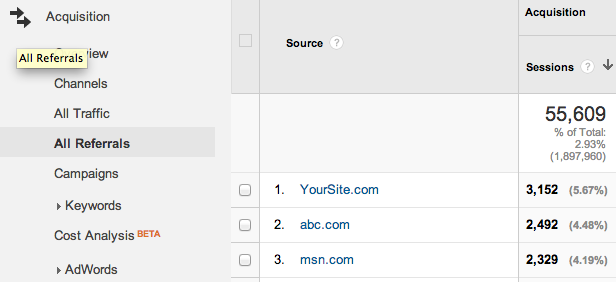
If you have configured Google Analytics to track across sessions across multiple domains and or subdomains, a small level of self-referrals is natural (Due to session timeouts). This is usually less than 1% of total traffic.
However, if you see a large amount of self-referrals in your reports, you have a problem.
Why Should You Fix Self-Referrals?
Data integrity, bad data leads to bad decisions.
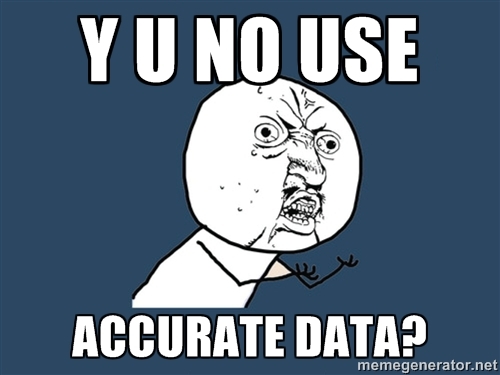
Self-referrals in Google Analytics can effect acquisition, behavior, and conversion data. That's basically all of your data! Let's take a deeper look. Self-referrals effect acquisition data because it artificially inflates channel sessions, usually for referrals. In cases where a second session isn't started and a self-referral still occurs, traffic coming from channels like direct and cpc can actually be recorded as visits coming from referrals. If this is the case, you'll need to talk with a Google Analytics Consultant from Three Ventures as an expert should be consulted. Self-referrals can also effect behavior and conversion data. If you're segmenting traffic by channel to see this data and have self-referral issues, there's a good chance that the data you're analyzing is inaccurate! Lets take a look. For example, say user "A" visits your website from paid search. On page three of the conversion path incorrect tracking with GA or conflicting configurations on your site cause user A to trigger a self-referral by beginning a second session. Next user A continues and checkouts on your site buying $100 worth of products. Oh no... that's going to lead to some data issues, here's why:
- User A Triggered Two Sessions: Sessions are incorrectly overstated!
- Two Sessions Create Two Sets Of Behavior Data: Metrics like time on site and visitor flow are specific to each session and do not share the data with one another!
- Only One Session Gets Conversion Credit: Referral gets credit for the conversion, not Paid Search! (GA will always override the last non-direct click)
... and what does this lead to? If you're trying to analyze behavior by channel, you're analyzing sessions that only have part of what actually happened. For example, the first session grouped in the channel 'Paid Search' would only show the behavior metrics for the first three pages as the second session started after the third page. This can lead you to make misinformed decisions about user behavior! If you're trying to analyze conversions by channel, you're analyzing channels with the wrong conversion data. This can lead you to make misinformed marketing decisions about your channels which could be costly! Take a look at the images below. Notice how the % of total conversions on the left is less for Direct, Paid, and Organic search, and more for referrals than compared to the image on the right. This is what happens to the distribution of conversion credit by channel when your site has self-referral issues.
Channel % of Total Conversions - Self-Referrals Issues
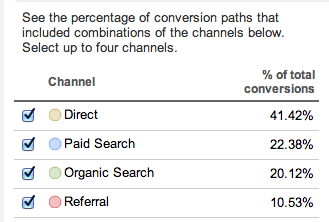
Channel % of Total Conversions - No Self-Referrals Issues
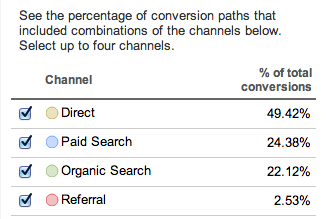
Do you see how this could lead you to make decisions based upon bad data? Next lets take a look at the two common causes of self-referrals and how to fix them.
Three Main Causes Of Self-Referrals In Google Analytics
The three main types of self-referrals come from:
- Incorrect configuration of cross domain tracking
- Either with incorrect implementation of the linker plugin for cross domain tracking
- OR by having forms or other JavaScript functions which don't pass cookie values through a cross domain link
- Missing tracking code on a page.
If you're missing tracking code on a page this will cause a session to end and a new session to start as the user clicks to the next page on your site that includes tracking code. Since the page without tracking code ends the current session of the user, it will count as a referral (From your domain) when the user goes to the next page, starting a second session.
UPDATE: Additional Issues That Cause Self-referrals
After fixing many of your self-referral issues, we've also pinpointed two other causes of self referrals:
- Improper use of UTM tags on internal links
- Manipulation of header data (For example single sign on solutions or platforms which have multiple redirect loops)
If you're tagging internal links with UTM parameters, please stop. Instead, contact us for help using custom dimensions and filters to track your internal campaigns. It's more efficient and doesn't overwrite where traffic initially comes from. If you have checked all the known issues, and think manipulation of header data may be the issue, contact us for more information.
If you have an identity solution with redirects - a solution gets very complicated depending on how traffic gets to the sign on portal, and where they are redirected to after login. We recommend you contact us in this case.
Isolating The Source Self-Referrals In The Landing Page Report
Understanding what is causing your self-referrals can be done in a three steps. In the third step, we built you an advanced segment to import into your Google Analytics account which you will need for analysis. The three steps are as follows:
- Go To The Landing Page Report
- Apply The Secondary Dimension Of "Full Referrer"
- Apply The Advanced Segmented Provided Below (Obtain via email)
In doing so, you will build a report that shows all the self-referrals from your domain (Or domains if you have cross domain tracking).
Download The Advanced Segment Needed
Download this advanced segment. Upon import, make sure that you change the referral path to your domain. If you use cross domain tracking, click 'or' to add another domain, continue until you have all the domains that you use cross domain tracking for. Now go to Google Analytics and go to the landing pages report. Then apply a secondary dimension of "Full Referrer".
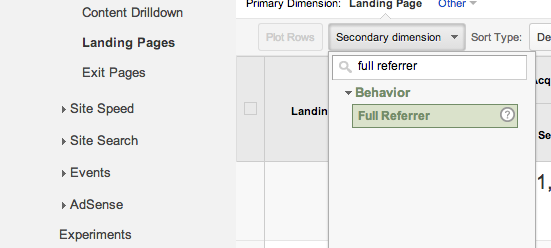
Now apply the advanced segment we sent you via email. Make sure that you change the referral path upon implementation to your domain. If you use cross domain tracking, click or to add another domain, continue until you have all the domains that you use cross domain tracking for.
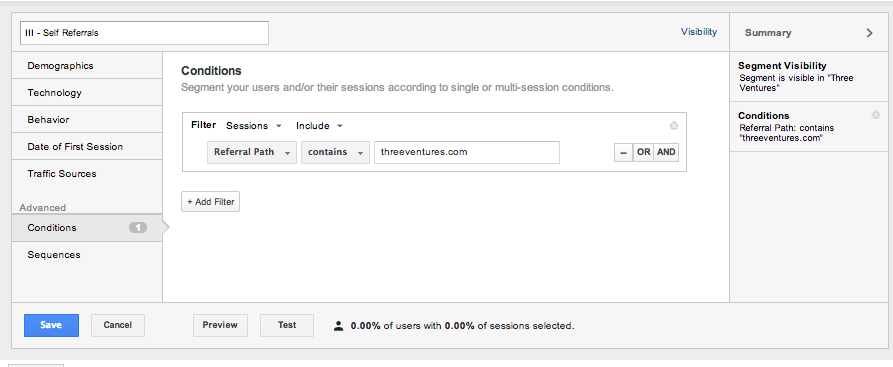
You should see a report like the following, except with data if you have self-referral problems. Notice that our report shows no self-referral issues :)

How To Fix Self-Referrals In Google Analytics
Take a look at the report you now have. If the landing page and the full referrer are on the same domain, the page that is the full referrer is most likely missing the Google Analytics snippet. The fix is easy, add the tracking code!
If this page has tracking code and is still causing self-referrals, you'll need to contact our Google Analytics Consultants as there's a more advanced problem causing your issues which will require an expert's help. If the landing page and full referrer are on separate domains (example.com and checkout.example.com), you have incorrectly configured cross domain tracking. If this is the case, review the configurations of cross domain tracking to ensure that you have set them up correctly:
- Cross Domain Tracking Using Google Tag Manager (Universal Analytics and Google Analytics)
- Cross Domain Tracking With Universal Analytics
- Cross Domain Tracking With Google Analytics
Cross Domain Tracking With The Linker Plugin Can Cause Self-referrals
If you're using the linker plugin in Google Tag Manager or in your Gtag code, this can cause self referrals. This is because the plugin adds cookies to HTML links on your site which link to the specified domain that you want to link to. However, it doesn't auto add cookies to form data, plugins, widgets, or JavaScript handlers or functions which would send a user to the domain you want to cross link to. Some examples of this are:
- Contact forms (which redirect a user to a different domain)
- Configuration widgets (Like Synxis or other booking widgets)
- Single page JavaScript applications (who's links are compiled and executed "onClick" or with a handler)
- Embedded iFrames
In most cases above, you need an experienced developer to build custom scripts to ensure cookies are appended onto the cross domain request.
Summary: How To Fix Self-Referrals In Google Analytics
Remember that the two main causes of self-referrals in Google Analytics come from missing tracking code and misconfiguration of cross domain tracking. Of course there are other ways that self-referrals happen, but these require technical analysis and advanced solutions. If this is the case, don't hesitate to contact our Google Analytics Consultants for help. And as always, you can tweet @ThreeVentures with your Google Analytics questions or thoughts and don't forget to let us know what you think in the comments below! Need help optimizing your website or marketing machine? Get in touch with us.





















